All HONDA CR-V 2011 RD1-RD5, RE7 / 3.G Service Manual
[x] Cancel search | Manufacturer: HONDA, Model Year: 2011, Model line: CR-V, Model: HONDA CR-V 2011 RD1-RD5, RE7 / 3.GPages: 445, PDF Size: 8.06 MB
Page 54 of 445
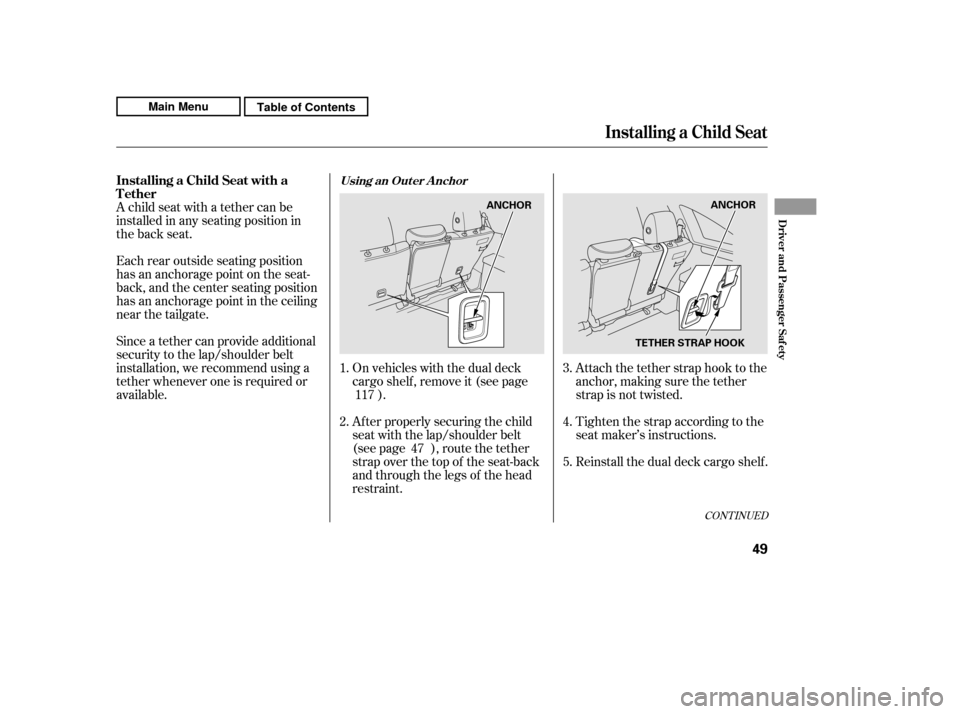
A child seat with a tether can be
installed in any seating position in
the back seat.
Each rear outside seating position
has an anchorage point on the seat-
back, and the center seating position
has an anchorage point in the ceiling
near the tailgate.
Since a tether can provide additional
security to the lap/shoulder belt
installation, we recommend using a
tether whenever one is required or
available.Attach the tether strap hook to the
anchor, making sure the tether
strap is not twisted.
Tighten the strap according to the
seat maker’s instructions.
Reinstall the dual deck cargo shelf .
On vehicles with the dual deck
cargoshelf,removeit(seepage
).
Af ter properly securing the child
seat with the lap/shoulder belt
(see page ), route the tether
strap over the top of the seat-back
and through the legs of the head
restraint.
1.
3.
2. 4. 5.
117
47
CONT INUED
Installing a Child Seat with a
TetherUsing an Out er A nchor
Inst alling a Child Seat
Driver and Passenger Saf ety
49
TETHER STRAP HOOK ANCHOR
ANCHOR
Main MenuTable of Contents
Page 55 of 445
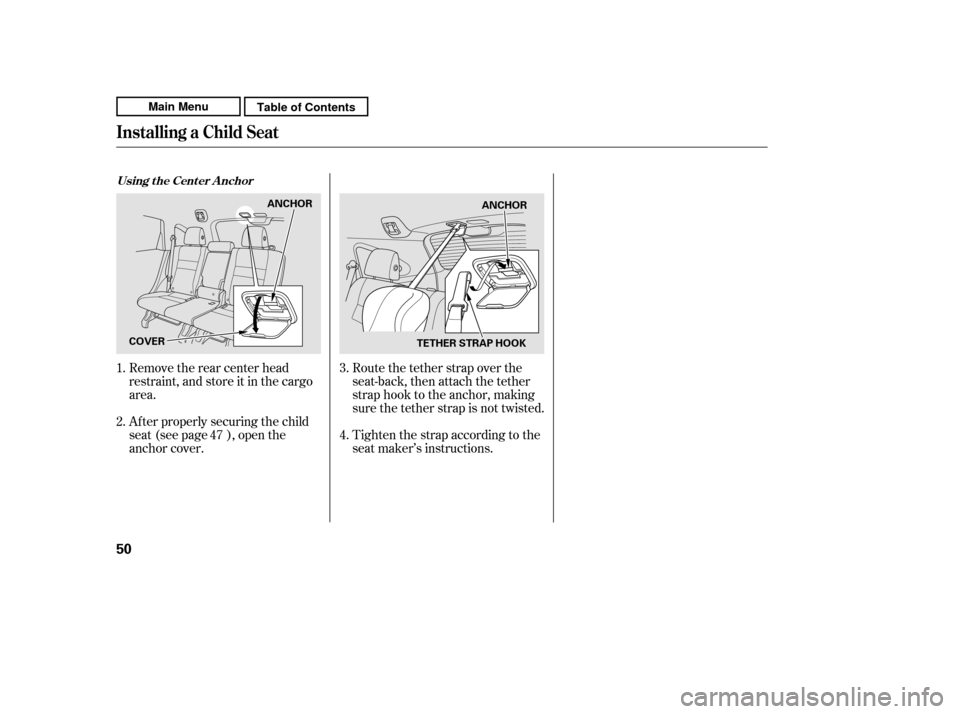
Route the tether strap over the
seat-back, then attach the tether
strap hook to the anchor, making
sure the tether strap is not twisted.
Tighten the strap according to the
seat maker’s instructions.
Af ter properly securing the child
seat (see page ), open the
anchor cover.
Remove the rear center head
restraint, and store it in the cargo
area.
1. 2. 3. 4.
47
Using t he Cent er A nchor
Inst alling a Child Seat
50
TETHER STRAP HOOK
COVER ANCHOR
ANCHOR
Main MenuTable of Contents
Page 56 of 445
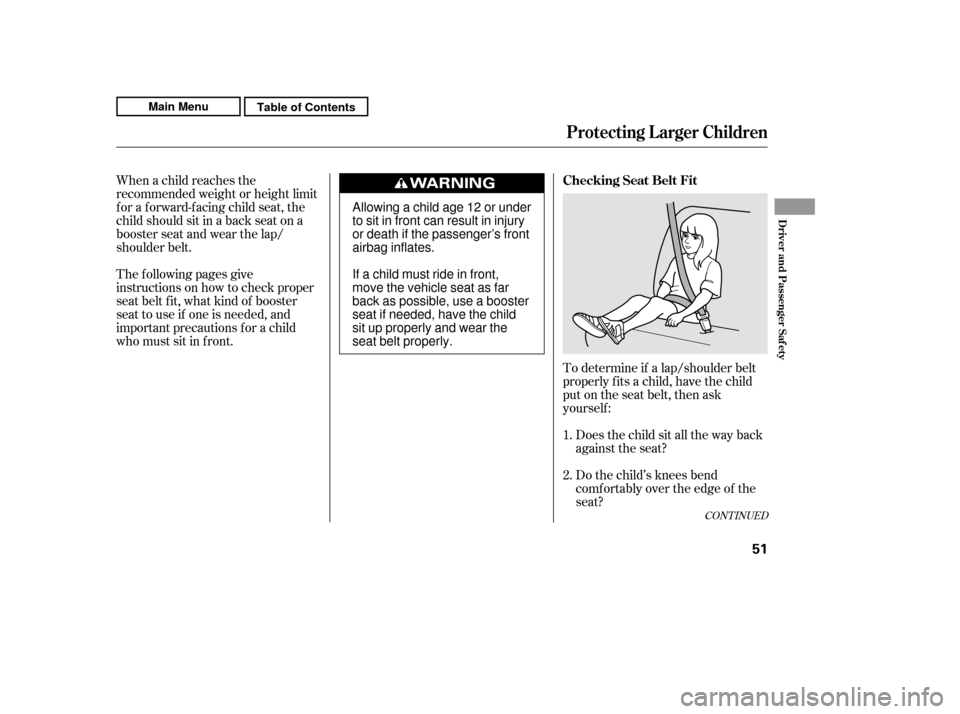
When a child reaches the
recommended weight or height limit
for a forward-facing child seat, the
child should sit in a back seat on a
booster seat and wear the lap/
shoulder belt.
The f ollowing pages give
instructions on how to check proper
seat belt f it, what kind of booster
seat to use if one is needed, and
important precautions f or a child
who must sit in f ront.To determine if a lap/shoulder belt
properly f its a child, have the child
put on the seat belt, then ask
yourself :Does the child sit all the way back
against the seat?
Do the child’s knees bend
comf ortably over the edge of the
seat?
1. 2.
CONT INUED
Checking Seat Belt Fit
Protecting L arger Children
Driver and Passenger Saf ety
51
Allowing a child age 12 or under
to sit in front can result in injury
or death if the passenger’s front
airbag inflates.
If a child must ride in front,
move the vehicle seat as far
back as possible, use a booster
seat if needed, have the child
sit up properly and wear the
seat belt properly.
Main MenuTable of Contents
Page 57 of 445
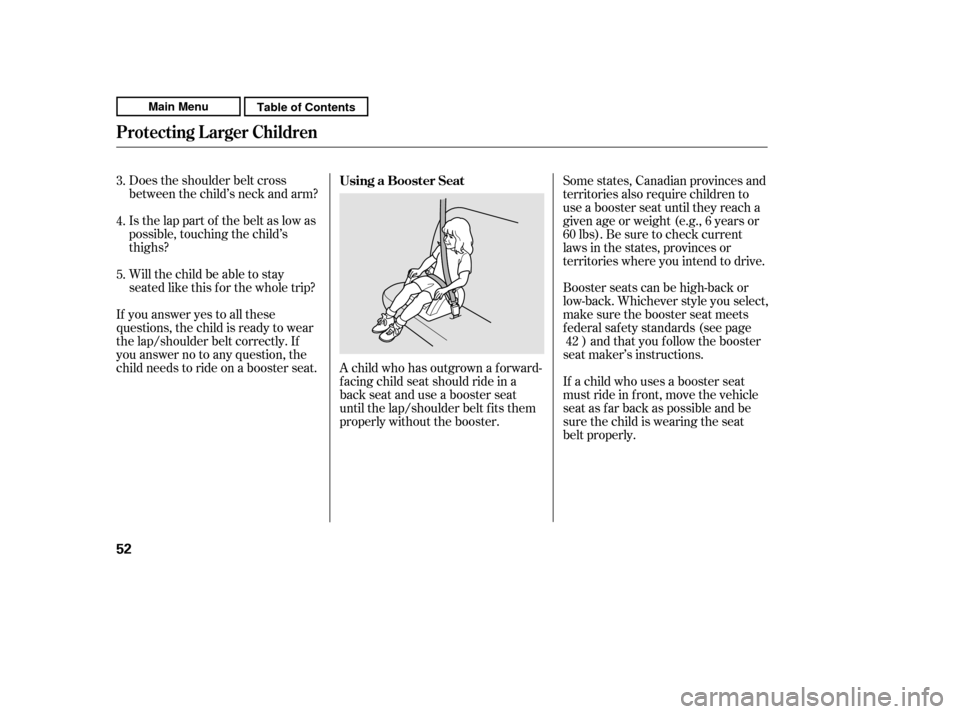
Does the shoulder belt cross
between the child’s neck and arm?
Is the lap part of the belt as low as
possible, touching the child’s
thighs?
Will the child be able to stay
seated like this f or the whole trip?
If you answer yes to all these
questions, the child is ready to wear
the lap/shoulder belt correctly. If
you answer no to any question, the
child needs to ride on a booster seat. A child who has outgrown a f orward- f acing child seat should ride in a
back seat and use a booster seat
until the lap/shoulder belt f its them
properly without the booster.Booster seats can be high-back or
low-back. Whichever style you select,
make sure the booster seat meets
f ederal saf ety standards (see page
) and that you f ollow the booster
seat maker’s instructions.
If a child who uses a booster seat
must ride in f ront, move the vehicle
seat as far back as possible and be
sure the child is wearing the seat
belt properly.
Some states, Canadian provinces and
territories also require children to
use a booster seat until they reach a
given age or weight (e.g., 6 years or
60lbs).Besuretocheckcurrent
laws in the states, provinces or
territories where you intend to drive.
3. 4. 5.
42
Using a Booster Seat
Protecting L arger Children
52
Main MenuTable of Contents
Page 58 of 445

A child may continue using a booster
seat until the tops of their ears are
even with the top of the vehicle’s or
booster’s seat-back. A child of this
height should be tall enough to use
the lap/shoulder belt without a
booster seat.
The National Highway Traffic Safety
Administration and Transport
Canada recommend that all children
aged 12 and under be properly
restrained in a back seat.
If the passenger’s front airbag
inf lates in a moderate to severe
f rontal collision, the airbag can cause
serious injuries to a child who is
unrestrained, improperly restrained,
sitting too close to the airbag, or out
of position.A side airbag also poses risks. If any
part of a larger child’s body is in the
path of a deploying side airbag, the
child could receive possibly serious
injuries.
Of course, children vary widely. And
while age may be one indicator of
when a child can saf ely ride in f ront,
there are other important f actors you
should consider.
Physically, a child must be large
enough f or the lap/shoulder belt to
properly f it (see pages and ). If
the seat belt does not f it properly,
with or without the child sitting on a
booster seat, the child should not sit
in f ront.
To saf ely ride in f ront, a child must
be able to f ollow the rules, including
sitting properly, and wearing the seat
belt properly throughout a ride.If you decide that a child can saf ely
ride up f ront, be sure to:
Caref ully read the owner’s manual,
and make sure you understand all
seat belt instructions and all saf ety
inf ormation.
Move the vehicle seat to the rear-
most position.
Have the child sit up straight, back
against the seat, and feet on or
near the f loor.
Check that the child’s seat belt is
properly and securely positioned.
Supervise the child. Even a mature
child sometimes needs to be
reminded to f asten the seat belt or
sit properly.
15 51
When Can a L arger Child Sit in
Front
Physical Size
Maturity
Protecting L arger Children
Driver and Passenger Saf ety
53
Main MenuTable of Contents
Page 60 of 445
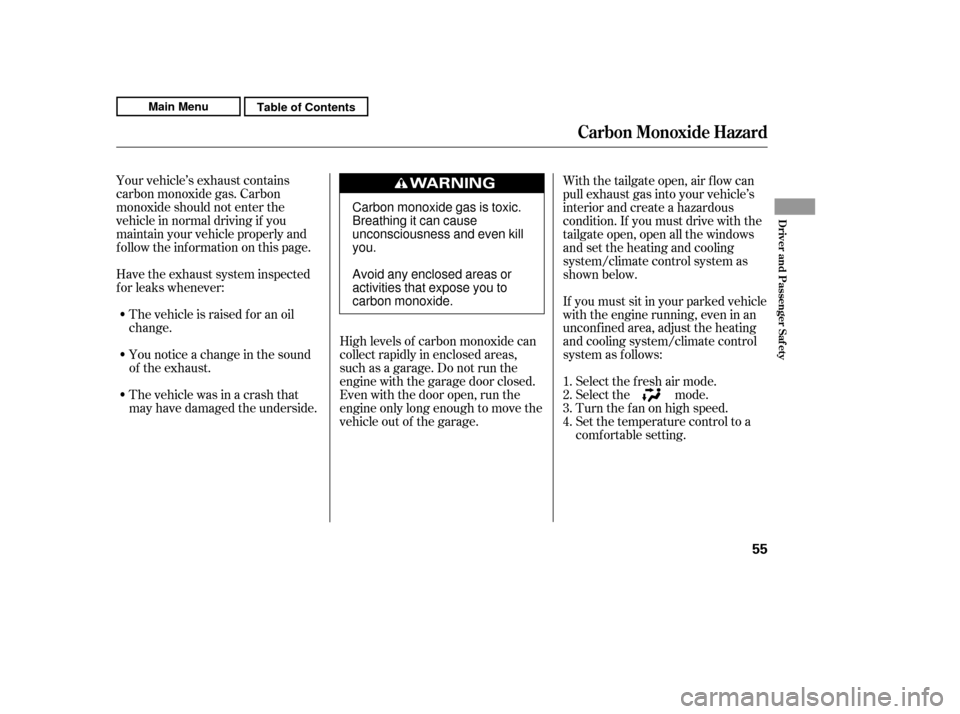
Your vehicle’s exhaust contains
carbon monoxide gas. Carbon
monoxide should not enter the
vehicle in normal driving if you
maintain your vehicle properly and
f ollow the inf ormation on this page.
Have the exhaust system inspected
f or leaks whenever:High levels of carbon monoxide can
collect rapidly in enclosed areas,
such as a garage. Do not run the
engine with the garage door closed.
Even with the door open, run the
engine only long enough to move the
vehicle out of the garage.
The vehicle is raised f or an oil
change.
You notice a change in the sound
of the exhaust.
The vehicle was in a crash that
may have damaged the underside. With the tailgate open, air flow can
pull exhaust gas into your vehicle’s
interior and create a hazardous
condition. If you must drive with the
tailgate open, open all the windows
and set the heating and cooling
system/climate control system as
shown below.
Select the f resh air mode.
Select the mode.
Turn the f an on high speed.
Set the temperature control to a
comfortable setting.
If you must sit in your parked vehicle
with the engine running, even in an
unconf ined area, adjust the heating
and cooling system/climate control
system as f ollows: 1. 2.3.4.
Carbon Monoxide Hazard
Driver and Passenger Saf ety
55
Carbon monoxide gas is toxic.
Breathing it can cause
unconsciousness and even killyou.
Avoid any enclosed areas or
activities that expose you to
carbon monoxide.
Main MenuTable of Contents
Page 64 of 445

This section gives inf ormation about
the controls and displays that
contribute to the daily operation of
your vehicle. All the essential
controls are within easy reach............................
Control Locations . 60
............................
Instrument Panel . 61 ..........
Instrument Panel Indicators . 62
.............................................
Gauges . 68
....................
Inf ormation Display . 69
...................................
Trip Meter . 69
................
Instant Fuel Economy . 70
..............
Average Fuel Economy . 70
...........................................
Range . 70
.....................................
Odometer . 71
..................................
Fuel Gauge . 71
...................
Temperature Gauge . 71
Outside Temperature
..................................
Indicator . 71
..........
Check Fuel Cap Message . 73
...............
Maintenance Minder . 73
Controls Near the Steering
...........................................
Wheel . 74
.
Windshield Wipers and Washers . 75
.........
Turn Signals and Headlights . 76
........
Instrument Panel Brightness . 79
.................
Hazard Warning Button . 79
.................
Rear Window Def ogger . 80
.................................
Parking Brake . 81
..........
Steering Wheel Adjustment . 81
...............................
Keys and Locks . 82
........................
Immobilizer System . 83
................................
Ignition Switch . 84 ......................................
Door Locks . 85
......................
Power Door Locks . 85
.
Auto Door Locking/Unlocking . 86
..............
Childproof Door Locks . 91
.......................
Remote Transmitter . 92
............................................
Tailgate . 95
.................................................
Seats . 97
..................................
Seat Heaters . 111
............................
Power Windows . 112
.......................................
Moonroof . 113
...........................................
Mirrors . 114
.........
Interior Convenience Items . 116
............
Dual Deck Cargo Shelf . 117
.....................
Beverage Holders . 119
.............................
Center Table . 120
......................
Lower Glove Box . 120
......................
Upper Glove Box . 121
............................
Vanity Mirror . 121
...................................
Sun Visor . 122
....................
Sunglasses Holder . 122
................
Conversation Mirror . 123
........
Accessory Power Sockets . 123
.............
Console Compartment . 124
..................................
Coat Hook . 125
.......................
Seat Under Tray . 125
...............................
Interior Lights . 126
Instruments and Controls
Inst rument s and Cont rols
59
TM
Main Menu
Page 68 of 445

If either of you do not f asten your
seat belt while driving, the beeper
will sound and the indicator will f lash
again at regular intervals. For more
inf ormation, see page .This indicator normally comes on f or
a f ew seconds when you turn the
ignition switch to the ON (II)
position, and when the ignition
switch is turned to the START (III)
position. If it comes on at any other
time, there is a problem in the ABS.
If this happens, have your vehicle
checked by your dealer. With the
indicator on, your vehicle still has
normal braking ability but no anti-
lock. For more inf ormation, see page
.
This indicator comes on brief ly when
you turn the ignition switch to the
ON (II) position. If it comes on at
any other time, it indicates that the
passenger’s side airbag has
automatically shut off. For more
inf ormation, see page .
This indicator comes on brief ly when
you turn the ignition switch to the
ON (II) position. It will then go of f if
you have inserted a properly coded
ignition key. If it is not a properly
coded key, the indicator will blink,
and the engine’s f uel system will be
disabled (see page ).
This indicator comes on brief ly when
you turn the ignition switch to the
ON (II) position. If it comes on at
any other time, it indicates a
potential problem with your f ront
airbags. This indicator will also alert
you to a potential problem with your
airbag system components. For
more inf ormation, see page . 19
32
83 322
32
Instrument Panel Indicators
Supplemental Restraint
System Indicator Anti-lock Brake System
(A BS) Indicator
Immobilizer System
Indicator Side Airbag Of f
Indicator
Inst rument s and Cont rols
63
Canada
U.S.
Main MenuTable of Contents
Page 69 of 445
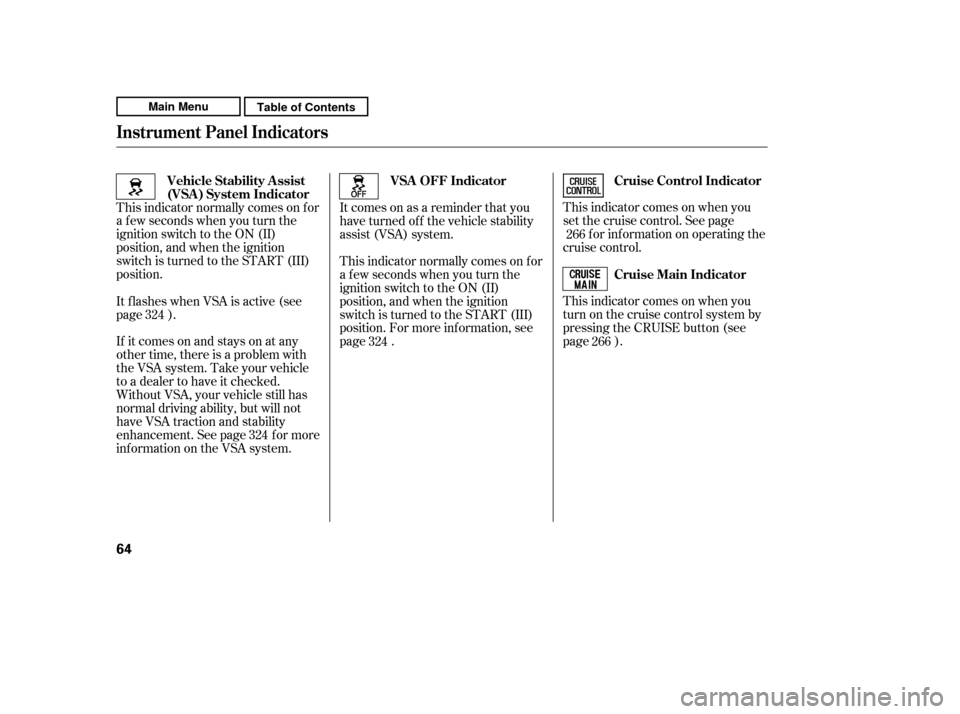
This indicator comes on when you
set the cruise control. See pagef or inf ormation on operating the
cruise control.
This indicator comes on when you
turn on the cruise control system by
pressing the CRUISE button (see
page ).
This indicator normally comes on f or
a f ew seconds when you turn the
ignition switch to the ON (II)
position, and when the ignition
switch is turned to the START (III)
position.
Itcomesonasareminderthatyou
have turned of f the vehicle stability
assist (VSA) system.
This indicator normally comes on f or
a f ew seconds when you turn the
ignition switch to the ON (II)
position, and when the ignition
switch is turned to the START (III)
position. For more inf ormation, see
page .
If itcomesonandstaysonatany
other time, there is a problem with
the VSA system. Take your vehicle
to a dealer to have it checked.
Without VSA, your vehicle still has
normal driving ability, but will not
have VSA traction and stability
enhancement. See page f or more
inf ormation on the VSA system.
It flashes when VSA is active (see
page ).
324266
266
324
324
Vehicle Stability Assist
(VSA ) System Indicator
Cruise Control Indicator
Cruise Main Indicator
VSA OFF Indicator
Instrument Panel Indicators
64
Main MenuTable of Contents
Page 70 of 445

This indicator comes on with the
high beam headlights. For more
inf ormation, see page .This indicator comes on as a
reminder that you must ref uel soon.
This indicator also comes on with
reduced brightness when the
daytime running lights (DRL) are on
(see page ).
If this indicator comes on when you
turn the ignition switch to the ON
(II) position and release the parking
brake, it means there is a problem
withtheDRL.Theremayalsobea
problem with the high beam
headlights. Have your vehicle
checked by your dealer.
When you press the hazard warning
button, both turn signal indicators
and all turn signals on the outside of
the vehicle f lash. When the indicator comes on, there
are about 2.3 U.S. gal (8.6
)of fuel
remaining in the tank.
When the needle reaches E, there is
a very small amount of f uel in the
tank.
The appropriate indicator comes on
in this display if the tailgate or any
door is not closed tightly.
The lef t or right turn signal indicator
blinks when you signal a lane change
or turn. If an indicator does not blink
or blinks rapidly, it usually means
one of the turn signal bulbs is
burned out (see pages and ).
Replace the bulb as soon as possible,
since other drivers cannot see that
you are signaling.
77
78
360 362 High Beam Indicator L ow Fuel Indicator
Daytime Running L ights
Indicator
Turn Signal and
Hazard Warning
Indicators
Door and Tailgate Open Indicator
Instrument Panel Indicators
Inst rument s and Cont rols
65
Main MenuTable of Contents